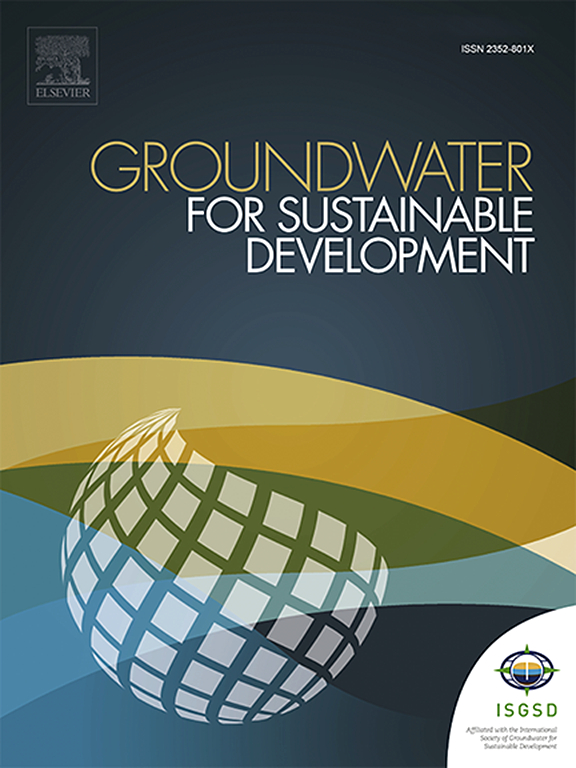Investigating the role of ENSO in groundwater temporal variability across Abu Dhabi Emirate, United Arab Emirates using machine learning algorithms
IF 4.9
Q2 ENGINEERING, ENVIRONMENTAL
引用次数: 0
Abstract
Accurate prediction of groundwater levels is crucial for managing groundwater resources efficiently. The complex aquifer heterogeneity and groundwater abstraction variation present challenges to have accurate groundwater level models over Abu Dhabi emirate, United Arab Emirates. In the present study, two data-driven models are employed, which are the Long Short-Term Memory (LSTM) and the Random Forest (RF) to develop a model for the prediction of monthly groundwater level in the Abu Dhabi Emirate. The incorporated data in the models are precipitation, terrestrial water storage, soil moisture, evapotranspiration, and the El Niño-Southern Oscillation (ENSO) 3.4 index. The groundwater monitoring wells data are obtained for 263 monitoring wells distributed over Abu Dhabi emirate for the period 2000–2023 in a monthly temporal scale. The models' performance was assessed using the Nash-Sutcliffe efficiency (NSE), root mean square error (RMSE) the coefficient of determination (R2) and Percent bias (PBIAS). An optimization technique was also applied to address the impact of the lags on enhancing the groundwater level model. The LSTM model outperformed the RF model during the testing period, achieving R2 = 0.79, NSE = 0.70, RMSE = 0.38 m and PBIAS = 0.2% with a 3-month lag. The global sensitivity analysis was applied to understand the importance of each parameter and its influence on the models’ output. This study highlights the potential use of data-driven models for the prediction of groundwater level which could aid water managers to monitor the groundwater resources at a regional scale. The developed model can serve as an alternative approach for predicting groundwater level change over the Abu Dhabi Emirate.

利用机器学习算法研究ENSO在阿联酋阿布扎比酋长国地下水时间变化中的作用
准确预测地下水位对有效管理地下水资源至关重要。阿拉伯联合酋长国阿布扎比酋长国复杂的含水层非均质性和地下水抽取变化给建立准确的地下水位模型带来了挑战。本研究采用长短期记忆(LSTM)和随机森林(RF)两种数据驱动模型,建立了阿布扎比酋长国月地下水位预测模型。模型中纳入的数据包括降水、陆地储水量、土壤湿度、蒸散发和El Niño-Southern涛动(ENSO) 3.4指数。本文获得了分布在阿布扎比酋长国境内的263口监测井2000-2023年的月时间尺度地下水监测井数据。采用Nash-Sutcliffe效率(NSE)、均方根误差(RMSE)、决定系数(R2)和百分比偏差(PBIAS)对模型的性能进行评估。采用优化技术解决了滞后效应对提高地下水位模型的影响。LSTM模型在测试期间优于RF模型,R2 = 0.79, NSE = 0.70, RMSE = 0.38 m, PBIAS = 0.2%,滞后3个月。采用全局敏感性分析来了解每个参数的重要性及其对模型输出的影响。这项研究强调了数据驱动模型在地下水位预测中的潜在用途,这可以帮助水资源管理者在区域尺度上监测地下水资源。开发的模型可以作为预测阿布扎比酋长国地下水位变化的替代方法。
本文章由计算机程序翻译,如有差异,请以英文原文为准。
求助全文
约1分钟内获得全文
求助全文
来源期刊

Groundwater for Sustainable Development
Social Sciences-Geography, Planning and Development
CiteScore
11.50
自引率
10.20%
发文量
152
期刊介绍:
Groundwater for Sustainable Development is directed to different stakeholders and professionals, including government and non-governmental organizations, international funding agencies, universities, public water institutions, public health and other public/private sector professionals, and other relevant institutions. It is aimed at professionals, academics and students in the fields of disciplines such as: groundwater and its connection to surface hydrology and environment, soil sciences, engineering, ecology, microbiology, atmospheric sciences, analytical chemistry, hydro-engineering, water technology, environmental ethics, economics, public health, policy, as well as social sciences, legal disciplines, or any other area connected with water issues. The objectives of this journal are to facilitate: • The improvement of effective and sustainable management of water resources across the globe. • The improvement of human access to groundwater resources in adequate quantity and good quality. • The meeting of the increasing demand for drinking and irrigation water needed for food security to contribute to a social and economically sound human development. • The creation of a global inter- and multidisciplinary platform and forum to improve our understanding of groundwater resources and to advocate their effective and sustainable management and protection against contamination. • Interdisciplinary information exchange and to stimulate scientific research in the fields of groundwater related sciences and social and health sciences required to achieve the United Nations Millennium Development Goals for sustainable development.
 求助内容:
求助内容: 应助结果提醒方式:
应助结果提醒方式:


